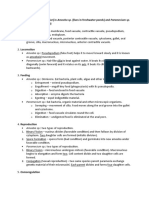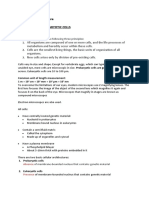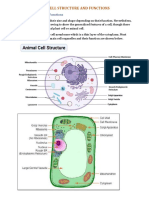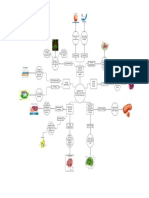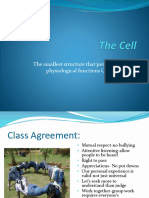Biolab: Animal Tissues Lab Report Name, Date, Course and Section Required For Password: 1409
Biolab: Animal Tissues Lab Report Name, Date, Course and Section Required For Password: 1409
Uploaded by
RosaCopyright:
Available Formats
Biolab: Animal Tissues Lab Report Name, Date, Course and Section Required For Password: 1409
Biolab: Animal Tissues Lab Report Name, Date, Course and Section Required For Password: 1409
Uploaded by
RosaOriginal Title
Copyright
Available Formats
Share this document
Did you find this document useful?
Is this content inappropriate?
Copyright:
Available Formats
Biolab: Animal Tissues Lab Report Name, Date, Course and Section Required For Password: 1409
Biolab: Animal Tissues Lab Report Name, Date, Course and Section Required For Password: 1409
Uploaded by
RosaCopyright:
Available Formats
BioLab3
Animal Tissues Lab Report
Name, date, course and section required for password: 1409
I. Epithelial Tissue
1. Define the following terms:
epithelial cells: Tightly linked together with little space and covers the exterior of an
organism.
basement membrane: Thin a cellular structure always located between any form of
epithelium and its underlying connective tissue.
2. Name the four types of tissues.
Epithelial, Connective, Muscle and Nervous
3. Based on Lab images, Section 1, Exercise 1, what functions are associated with
simple squamous epithelial tissue?
4. Based on Lab, Section 1, Exercise 2, examine the cross section of kidney. Identify
and list structures indicated.
Basement Membrane
Free Surface
Inside of Kidney Tubule
Cell Nucleus
5. Based on Lab, Section 1, Exercise 5, what does stratified mean?
That it is found in several layers.
6. Draw and label 4 types of epithelial cells, including both simple and stratified
varieties. Sign, date and prepare an image of your drawing and include it with your
lab report.
© 2016 Access Learning Systems A 1
II. Connective Tissue
1. Define the following terms:
Matrix: The nonliving material between cells that is produced and secreted
by the cells.
Fibroblasts: Irregular, branching cells that secrete strong fibrous proteins, collagen
and elastin.
loose connective tissue: Packing materials of the body, fills spaces between organs
and stabilizes cells.
Collagen: Fibrous protein; most abundant extracellular protein; forms the majority of
connective tissues.
elastic cartilage: Similar to hyaline cartilage, but more elastic fibers in matrix.
lamellae: Concentric layers of hard bony matrix surrounding haversian circles.
2. Based on Lab, Section II, Exercise 6, which of the labeled structure(s) imparts
elasticity?
Elastin.
3. Based on Lab, Section II, Exercise 7, in which region of the skin can dense irregular
connective tissue be found?
Nose, ear, skin; The irregularly arranged collagen fibers are embedded with
hair follicles, blood vessels, glands, and nerve endings.
4. Based on Lab, Section II, Exercise 8, why is the orientation of the fibers important for
the function of the tissue?
Movement occurs in one direction and allows for stretching of the fibers
5. Based on Lab, Section II, Exercise 9, which letter indicates an area of adipose tissue?
B
6. Based on Lab, Section II, Exercise 10, examine the image of hyaline cartilage and
identify the labeled structures.
A. Chondrocytes
B. Chondrin Matrix
7. Based on Lab, Section II, Exercise 11, why is such an elaborate system of canals
needed in bone more than in cartilage?
© 2016 Access Learning Systems A 2
The cartilage is loosely connected, and more durable.
The bones need a greater protection system.
8. Based on Lab, Section II, Exercise 11, examine the image of a human blood smear
and identify the labeled structures.
A. Plasma
B. Leukocyte
C. Thrombocyte
D. Erthrocyte
III. Muscle Tissue
1. What are intercalated disks?
Specialized junctions where cardiac muscle is branch and fix together.
2. Give the location, function, and appearance of the following muscle types:
Skeletal: Arms legs face and torso, Controls limb movement, Voluntary Striated
Multinucleated.
Smooth: Stomach, Involuntary control, Long and spindle, shaped.
Cardiac: Around the heart, Pumps blood throughout the body, Striated.
3. Based on Lab, Section III, Exercise 12, what are the bands or stripes you see
running perpendicular to the muscle fiber?
Striations
IV. Nervous Tissue
1. Draw a neuron and include the following labels: cell body, dendrites, axon. Use an
arrow to indicate the direction the impulse travels. Sign, date and prepare an image
of your drawing and include it with this lab report.
© 2016 Access Learning Systems A 3
2. Based on Lab, Section IV, Exercise 15, where in the human body would you be most
likely to find cell bodies? Brain, spinal cord, and dorsal root ganglia
V. Skin
1. List six functions of skin.
Protection, Absorption, Excretion, Secretion, Regulation and Sensation.
2. What is keratin?
Virtually insoluble and can act a barrier to penetration.
3. Based on Lab, Section V, Exercise 16, examine the model of skin and identify the
layers.
A. Keratinized layer
B. Epidermis
C. Dermis
D. Hypodermis
Summary Questions
Complete the following table:
Tissue Type
Appearance Function Location
Epithelial
Absorption,
Simple Irregular flat shape,
Secretion, Lung alveoli
squamous single layer.
Protection.
© 2016 Access Learning Systems A 4
Absorption,
Simple Scube shape, single
Secretion, Lines kidney tubules
cuboidal layer.
Protection.
Absorption and
Simple Single layer of long Lines small intestine,
secretion of
columnar column shaped cells ileum
mucus
Stratified Several layers of flat Skin, lining cheek,
protection
squamous cells esophagus
Provide the term or name the tissue that matches the following:
1. What is the matrix of blood?
Blood is considered a connective tissue because it has a matrix.
2. Organs that work together to carry out a specific function.
Orange System
3. Name two proteins associated with muscle movement.
Visceral- all cells work together as one unit.
Multi- unit cells can act and function independently.
4. A single layer of cells that is taller than it is wide.
Simple columnar epithelium
5. Type of tissue used for energy storage and insulation; cells appear like signet rings.
Adipose
6. Type of tissue that allows point to point communication in the body.
Nervous
7. Type of involuntary muscle made of elongated, spindle-shaped cells; found around many
internal organs.
Smooth
8. Type of tissue made up of a single layer of cube-shaped cells.
Connective
9. Type of tissue that lines the mouth.
Stratified squamous epithelium
10. Name and characterize the two main layers of skin.
Keratinocyte
© 2016 Access Learning Systems A 5
You might also like
- Histology of Plant and Animal CellsDocument4 pagesHistology of Plant and Animal Cellscikaifa40% (5)
- Experiment Cheek & OnionDocument2 pagesExperiment Cheek & OniondownloadpublishNo ratings yet
- NURSAKINAH NAJWAH BT SUHAIMI (Dissection and Observation of Plant Reproductive Organs)Document9 pagesNURSAKINAH NAJWAH BT SUHAIMI (Dissection and Observation of Plant Reproductive Organs)Nursakinah NajwahNo ratings yet
- Experiment f4 CellDocument3 pagesExperiment f4 CellAmsyidi AsmidaNo ratings yet
- 8.3 Microorganisms and VirusesDocument41 pages8.3 Microorganisms and VirusesHaslinda SheikhNo ratings yet
- Form 4 Revision QuizDocument80 pagesForm 4 Revision QuizEnvira LeeNo ratings yet
- Experiment BioDocument29 pagesExperiment BioQin Jamil100% (1)
- Experiment 4: Isolation of Microbes From Environmental SampleDocument3 pagesExperiment 4: Isolation of Microbes From Environmental SampleAnis SurayaNo ratings yet
- Chapter 2Document7 pagesChapter 2Kaness MathzNo ratings yet
- Experiment Lab 6Document8 pagesExperiment Lab 6exo kaiNo ratings yet
- Biology Form 4 Notes 2.3Document2 pagesBiology Form 4 Notes 2.3gelgabanNo ratings yet
- Chapter 3 Movement of Substances Across The Plasma MembraneDocument45 pagesChapter 3 Movement of Substances Across The Plasma MembraneNurul Husna100% (1)
- BIO303 Biochemistry IIDocument38 pagesBIO303 Biochemistry IIHanifullah JanNo ratings yet
- Study Different Stages of Mitosis in Onion Root TipDocument19 pagesStudy Different Stages of Mitosis in Onion Root TipfatemaNo ratings yet
- Experiment 4Document13 pagesExperiment 4Iqmal HafidzNo ratings yet
- Lab Bio411 As2011bDocument28 pagesLab Bio411 As2011bNURUL AIHAN AHMAD HILMINo ratings yet
- Cell Structure and FunctionDocument4 pagesCell Structure and FunctionAngeelina AgarwalNo ratings yet
- The Role of Useful Microorganisms in The EcosystemDocument16 pagesThe Role of Useful Microorganisms in The EcosystemMiz AkmaNo ratings yet
- Exp 1 Determination of Formula Unit of A Compound Pre Lab and LabDocument6 pagesExp 1 Determination of Formula Unit of A Compound Pre Lab and Labiffah shafiyahNo ratings yet
- Biological MoleculesDocument35 pagesBiological MoleculesRavneet KaurNo ratings yet
- Difference of Animal and Plant Cells (Onion and Cheek Cells) NotesDocument7 pagesDifference of Animal and Plant Cells (Onion and Cheek Cells) NotesAnjehyn ElleNo ratings yet
- Biology Updated 2 Iza and IkmalDocument25 pagesBiology Updated 2 Iza and IkmalEva WongNo ratings yet
- BIO - F5 - KSSM - CHAPTER - 1 - 1.1 and 1.2 ORGANISATION OF PLANT TISSUES AND GROWTHDocument59 pagesBIO - F5 - KSSM - CHAPTER - 1 - 1.1 and 1.2 ORGANISATION OF PLANT TISSUES AND GROWTHwienna1987100% (2)
- Assessment 1 MAT133 MarchAugust2023Document10 pagesAssessment 1 MAT133 MarchAugust2023さmuiNo ratings yet
- Experiment 2: Flame Test: ObjectivesDocument3 pagesExperiment 2: Flame Test: ObjectivesHana The Pencil KnightNo ratings yet
- 6.3 MeiosisDocument38 pages6.3 Meiosiswickedbiology101No ratings yet
- Chromosomal Mutations ActivityDocument3 pagesChromosomal Mutations ActivityLourdesCorpusMendozaNo ratings yet
- Chapter 3Document7 pagesChapter 3api-3841154No ratings yet
- Compilation of Experiments Form 4Document13 pagesCompilation of Experiments Form 4Marzila MohamedNo ratings yet
- 8 Compressed Notes Recombinant Technology SdsDocument7 pages8 Compressed Notes Recombinant Technology SdsSYAZWAN BIN MUSTAFA MoeNo ratings yet
- The History of Life On Earth G1Document31 pagesThe History of Life On Earth G1Mika Cossid100% (1)
- A CidDocument3 pagesA CidJerry Pui Chaw MinNo ratings yet
- Control and Coordination NotesDocument5 pagesControl and Coordination NotesNyra HillsNo ratings yet
- Final Lab Report As1201v Group 1 (Bio122)Document23 pagesFinal Lab Report As1201v Group 1 (Bio122)MUHAMMAD I'Z A'BDISSALAM MOHAMMAD FAIZALNo ratings yet
- Report 4: Practical 4: EnzymesDocument8 pagesReport 4: Practical 4: EnzymesĐặng Thị Kim SangNo ratings yet
- Lab Manual Exp 4Document7 pagesLab Manual Exp 4shirzNo ratings yet
- Phloem TransportDocument23 pagesPhloem TransportLex LinoNo ratings yet
- Transport Across Plasma Membrane PDFDocument2 pagesTransport Across Plasma Membrane PDFTracie Curry100% (1)
- Experiment 1 (Lab Report)Document8 pagesExperiment 1 (Lab Report)Rabiatul Adawiah0% (1)
- Biology Form 4 - Plant NutritionDocument6 pagesBiology Form 4 - Plant NutritionSharmini Rajagopal100% (1)
- Activity 2: Lizard Evolution Virtual Lab: Name: Evangelista, Arhlie Jane V. Section: BS BIO 3-1Document8 pagesActivity 2: Lizard Evolution Virtual Lab: Name: Evangelista, Arhlie Jane V. Section: BS BIO 3-1ArhlieJaneEvangelistaNo ratings yet
- Enzymes Lab ReportDocument13 pagesEnzymes Lab ReportIsland VitalNo ratings yet
- Chm125 Lab Manual Okt 2022Document25 pagesChm125 Lab Manual Okt 2022FiqajasmeNo ratings yet
- Lumphatic System Tortora DR - Compatibility ModeDocument22 pagesLumphatic System Tortora DR - Compatibility Modekamalab04No ratings yet
- Mastering Essay Question in Paper 3Document10 pagesMastering Essay Question in Paper 3Orkid Fazz100% (1)
- Types of Chemical Reactions: I. Purpose: II. MaterialsDocument4 pagesTypes of Chemical Reactions: I. Purpose: II. MaterialsJerneth Nyka FloresNo ratings yet
- Photosynthesis 1Document52 pagesPhotosynthesis 1Christian Benedict CruzNo ratings yet
- Report 5: Practical 5: Cell Divisions: Mitosis & MeiosisDocument4 pagesReport 5: Practical 5: Cell Divisions: Mitosis & MeiosisĐặng Thị Kim SangNo ratings yet
- BondingDocument51 pagesBondingchiyikomoshiNo ratings yet
- Digestion of Starch in HumansDocument7 pagesDigestion of Starch in HumansMOHD MU'IZZ BIN MOHD SHUKRINo ratings yet
- Design Experiment SPM BiologyDocument32 pagesDesign Experiment SPM BiologyEma94% (36)
- BIOL 1409 - Animal - Tissues - LR - Lab Report 4Document11 pagesBIOL 1409 - Animal - Tissues - LR - Lab Report 4Tonya Oliver100% (1)
- A&p Lab Ex 06aDocument6 pagesA&p Lab Ex 06amarycox1989100% (6)
- CH 099 TissuesDocument55 pagesCH 099 Tissuesalyssa bananNo ratings yet
- Worksheet On TissuesDocument5 pagesWorksheet On TissuesBryan AmoresNo ratings yet
- Tissues, Glands and Membranes: A. FunctionsDocument4 pagesTissues, Glands and Membranes: A. FunctionsRyan Cadorna FontanillaNo ratings yet
- CH 7 - Structural Organisation in AnimalsDocument8 pagesCH 7 - Structural Organisation in AnimalsLaxmiNo ratings yet
- Histology Self Quiz Intro and EpitheliumDocument3 pagesHistology Self Quiz Intro and EpitheliumJoonHong An100% (1)
- 3 Tissue of Human Body NotesDocument11 pages3 Tissue of Human Body Notesghanshyam agnihotryNo ratings yet
- TissuesDocument11 pagesTissuesReyni DeysNo ratings yet
- COMPONENT PreparationDocument75 pagesCOMPONENT PreparationFinu FarisaNo ratings yet
- 1 Histopathologic TechniquesDocument47 pages1 Histopathologic TechniquesShanne Katherine MarasiganNo ratings yet
- Blood Clotting NotesDocument12 pagesBlood Clotting NotesFateh MohammadNo ratings yet
- Biology 04 Cell Structure MCQ Quiz Openstax College PDFDocument21 pagesBiology 04 Cell Structure MCQ Quiz Openstax College PDFMuhammad IlyasNo ratings yet
- Anatomi Fisiologi HematologiDocument64 pagesAnatomi Fisiologi HematologiNada Putri IrfiantiNo ratings yet
- Cell BiologyDocument8 pagesCell BiologySharad DahalNo ratings yet
- Sudan Black B Stain: StabilityDocument2 pagesSudan Black B Stain: StabilityGeorgiana ZahariaNo ratings yet
- 482020104354AM-Class 9 Biology NotesDocument7 pages482020104354AM-Class 9 Biology Noteskmdmohideen2297No ratings yet
- Eukaryotic Cell OrganellesDocument7 pagesEukaryotic Cell OrganellesMary100% (2)
- PHCG 201 CytologyDocument113 pagesPHCG 201 CytologyIbn HaarūnNo ratings yet
- Cells: The Basic Unit of Life!!Document35 pagesCells: The Basic Unit of Life!!julie rainesNo ratings yet
- علم الانسجة د. احمد نعمانDocument379 pagesعلم الانسجة د. احمد نعمانLaila AlhadiNo ratings yet
- Chapter 4Document29 pagesChapter 4skywalkerNo ratings yet
- Cancer Cytopathology - 2017 - La Fortune - Improvements in Cell Block Processing The Cell Gel MethodDocument10 pagesCancer Cytopathology - 2017 - La Fortune - Improvements in Cell Block Processing The Cell Gel MethodVlad TomaNo ratings yet
- Grade 7 Unicellular OrganismsDocument10 pagesGrade 7 Unicellular OrganismsGadgetGlitchKillNo ratings yet
- Bio Mcqs 2pgDocument91 pagesBio Mcqs 2pgfarman ullahNo ratings yet
- ANATOMY AND PHYSIOLOGY BloodDocument4 pagesANATOMY AND PHYSIOLOGY BloodJonski JamNo ratings yet
- C. HPCT File Week 1 Introduction To General Pathology and HistoTechniquesDocument32 pagesC. HPCT File Week 1 Introduction To General Pathology and HistoTechniquesAliah Anne MagnoNo ratings yet
- Kuliah 1 - PendahuluanDocument18 pagesKuliah 1 - PendahuluanM Nur M. MahmudNo ratings yet
- MLS 014 - Sas 1Document4 pagesMLS 014 - Sas 1Ylia MastarsNo ratings yet
- Lodish - Molecular - Cell - Biology - 5ed - 1-145-194 (1) - 15-25Document11 pagesLodish - Molecular - Cell - Biology - 5ed - 1-145-194 (1) - 15-25Ary MadinaNo ratings yet
- Unified 1 Introduction To Anatomy PMSC 211 S 20Document21 pagesUnified 1 Introduction To Anatomy PMSC 211 S 20ran8384080No ratings yet
- R JOLAD Standard Price List - 2024Document231 pagesR JOLAD Standard Price List - 2024Areh BrytNo ratings yet
- BIOCHEM-LAB ACTIVITY 2 (Caminos, Keen Jude)Document2 pagesBIOCHEM-LAB ACTIVITY 2 (Caminos, Keen Jude)Keen Jude CaminosNo ratings yet
- 1.1.9 The Cell Structure and FunctionsDocument5 pages1.1.9 The Cell Structure and FunctionsAhenkan kwameNo ratings yet
- Fracture Healing: Akshayaa.B First Year Mds Dept of ProsthodonticsDocument21 pagesFracture Healing: Akshayaa.B First Year Mds Dept of ProsthodonticsAkshayaa BalajiNo ratings yet
- Biology Cells Graphic OrganizerDocument1 pageBiology Cells Graphic OrganizerMaci StackhouseNo ratings yet
- The Cell Student Ppt1Document48 pagesThe Cell Student Ppt1anaflaviaaguiarNo ratings yet
- Eukaryotic Cell Vs Prokaryotic Cell - Difference and Comparison - DiffenDocument9 pagesEukaryotic Cell Vs Prokaryotic Cell - Difference and Comparison - DiffenManendra Patwa100% (1)
- Human Tissues PPTDocument40 pagesHuman Tissues PPTKeneth CandidoNo ratings yet










